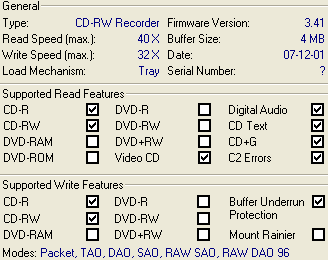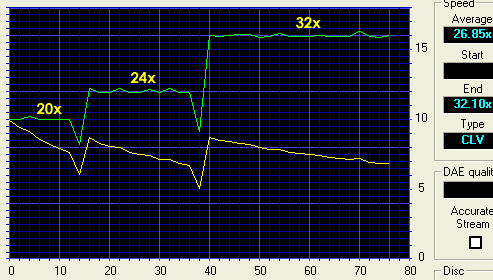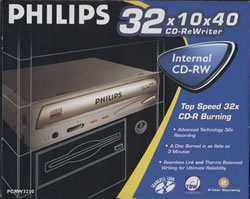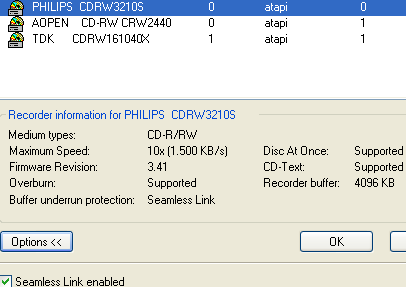32x CD-RW Roundup Vol2
3. Data Tests
Review Pages
2. Introduction - Page 2
3. Data Tests
4. CloneCD reading Tests
5. DAE Tests
6. CDR Tests - Page 1
7. CDR Tests - Page 2
8. Writing Quality of AOpen
9. Writing Quality of CyberDrive
10. Writing Quality of Philips
11. RW-Packet Writing Tests
12. Conclusion
13. CDR Tests - Page 3
14. Introduction - Page 3
32x CD-RW Roundup Vol 2 - Page 3
- Philips PCRW3210
 The
drive supports 32x writing (Z-CLV), 10x re-writing, 4MB Buffer, "SeamLess
Link" as the main anti-buffer underrun technology and "Thermo Balanced
Writing" for better writing quality. The maximum reading speed of the drive
is 40x (CAV). The exact writing speeds are 4x, 8x, 12, 16x, 20x (CLV) and 32x
(20x-32x). The re-writing speeds are 4x, 8x and 10x. The drive doesn't support
Mt. Rainier format. The drive includes a C2 error reporting and supports all
known writing modes (DAO, SAO, TAO and RAW).
The
drive supports 32x writing (Z-CLV), 10x re-writing, 4MB Buffer, "SeamLess
Link" as the main anti-buffer underrun technology and "Thermo Balanced
Writing" for better writing quality. The maximum reading speed of the drive
is 40x (CAV). The exact writing speeds are 4x, 8x, 12, 16x, 20x (CLV) and 32x
(20x-32x). The re-writing speeds are 4x, 8x and 10x. The drive doesn't support
Mt. Rainier format. The drive includes a C2 error reporting and supports all
known writing modes (DAO, SAO, TAO and RAW).
- Philips 32x writing speed
The Philips PCRW3210 supports 32x writing speed with the use of the Z-CLV writing technology. Below it's the Nero CD Speed writing graph that illustrates the use of Zone-CLV writing technology:

The 32x writing speed range is divided in 3 zones: The drive starts writing at 20x from the lead-in area till 12mins, shifts up to 24x at 16mins and lastly shifts to 32x at 40mins and stays there until the end. The average recording speed is 26.85X, which makes it the faster 32x recorder, at least according to the Nero CD Speed writing test.
The drive will write almost all CDs at 32x, even lower quality media. That may cause some problems especially when the drive is connected at UDMA33 mode (default). We experienced some unreadable CDs, and the problem was solved as soon as we forced the drive to work at MultiDMA2 or PIO Mode4 by removing the UDMA33 jumper. We advise our users to perform the same task in order get the maximum writing readability.
- The package
 The
package supplied was a "GOLD" retail European version. This included:
the drive itself, an installation guide, a warranty registration form, audio
cable and one (1) piece of Philips 80min 32x CD-R blank (actual manufacturer
Ritek). The package doesn't offer a HS-RW media. The software supplied with
the drive was Nero v5.5.5.6 and InCD v3.14. The drive has a 2-year warranty
(only in Europe). The drive's price is estimated to be 175 Euro plus Tax.
The
package supplied was a "GOLD" retail European version. This included:
the drive itself, an installation guide, a warranty registration form, audio
cable and one (1) piece of Philips 80min 32x CD-R blank (actual manufacturer
Ritek). The package doesn't offer a HS-RW media. The software supplied with
the drive was Nero v5.5.5.6 and InCD v3.14. The drive has a 2-year warranty
(only in Europe). The drive's price is estimated to be 175 Euro plus Tax.
The front panel of the drive includes 2 leds (busy, write), the manual eject hole, the headphone jack/volume control and the logos of "Philips", "High-Speed RW" and "CDRW3200 Series". The tray colour tends to be GOLD:

At the back of the drive we will find the usual connectors (IDE interface, power), the jumpers for making the drive Master/Slave, the SPDIF output connector and the analog / digital output connectors. There are 3 jumpers at the left of the back. The 2 jumpers on the left are not used (factory reserved), and the third is being used for making the drive working at UDMA33 mode. If you remove the third jumper, the drive works at PIO-Mode4 mode - which is SUGGESTED!

- Installation
 The
Philips PCRW3210 was installed as a Master in the secondary IDE Bus. The drive
worked in PIOMode4 and after booting, identified itself as "Philips CDRW3210S".
The
Philips PCRW3210 was installed as a Master in the secondary IDE Bus. The drive
worked in PIOMode4 and after booting, identified itself as "Philips CDRW3210S".
We used WinXP for the recording tests. Note that Windows standard IDE Busdriver's DMA was not activated and the test results were poor. Even when we installed VIA's 4.37 drives didn't fixed the problem. To have the best performance, you must install VIA's IDE Busmaster drives (3.14) of course in case you are using a VIA chipset motherboard. Note that after installing VIA's IDE Busmaster drivers, some recording software (InCD) will not function properly...
The drive was a December 2001 model with firmware revision v3.41 installed. We used Nero (5.5.7.2), InCD (3.21) and CloneCD (3.3.4.1) for the recording tests:

Review Pages
2. Introduction - Page 2
3. Data Tests
4. CloneCD reading Tests
5. DAE Tests
6. CDR Tests - Page 1
7. CDR Tests - Page 2
8. Writing Quality of AOpen
9. Writing Quality of CyberDrive
10. Writing Quality of Philips
11. RW-Packet Writing Tests
12. Conclusion
13. CDR Tests - Page 3
14. Introduction - Page 3













